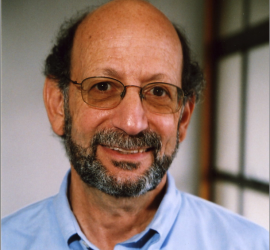George M. “Bud” Homsy

In Memoriam
George M. “Bud” Homsy
1943 - 2024
On March 12, UCSB and the fluid mechanics community lost a cherished colleague with the passing of George M. “Bud” Homsy from cancer. Bud is survived by his wife of 59 years, Barbara “Bryn” Homsy, and two sons: George “Geo” Homsy of Mount Shasta, California, and Robert “Rob” Homsy of Los Angeles.
Bud was born on August 29, 1943, in Fresno, California. Educated as a chemical engineer, Bud received his bachelor’s degree with honors in 1965 from UC Berkeley, and his MS and PhD from the University of Illinois in 1967 and 1969, respectively. Bud’s thesis research at Illinois focused on thermal convection and was supervised by Jack Hudson. Upon completing a NATO postdoctoral fellowship at Imperial College, London, Bud joined the Department of Chemical Engineering at Stanford as an assistant professor in 1970, and was promoted to associate professor in 1976 and full professor in 1979. In 2001, Bud moved to UC Santa Barbara as professor of mechanical engineering, where he also served as department chair. In 2010 he joined the University of British Columbia as professor of mathematics and mechanical engineering. From 2014 until his death he was affiliate professor of mechanical engineering at the University of Washington.
Bud’s research was remarkable for its breadth and depth. He launched efforts that ultimately led to important contributions in the areas of interfacial fluid mechanics (particularly thin-film, Marangoni, and drop/bubble flows) and particulate flows (e.g., fluidization, sedimentation), all while continuing to make advances on a variety of problems related to thermal convection. Bud also made significant contributions to the areas of porous media flows and viscoelastic fluid mechanics. Particularly notable is the work he led on the problem of viscous fingering, which occurs when a less viscous fluid displaces a more viscous one in a porous medium. Some of that work is described in his classic 1987 Annual Reviews of Fluid Mechanics article, which has been referenced over 2000 times as of this writing.
Bud authored or co-authored more than 150 papers in the field of fluid mechanics and transport phenomena. His work was especially influential as it employed not only theoretical approaches, in particular asymptotic analysis, but also experiments and computations. Another major reason for the long-lasting influence of Bud’s scholarship is the clarity, thoroughness, and elegance of his papers. Throughout all of this work, hydrodynamic stability was a major theme, as was the elucidation of physical mechanisms underlying whatever phenomena were under study.
Bud’s accomplishments were well recognized by his peers. He was a fellow of the American Physical Society, which awarded him the 2004 Fluid Dynamics Prize, and he served as chair of its Division of Fluid Dynamics during 1989-1990. Other honors include a Bing Fellowship for excellence in teaching at Stanford, Midwest Mechanics Speaker, Talbot Lecturer at UIUC, Batchelor Visitor at DAMTP, Cambridge, and an honorary doctorate from Paul Sabatier University, Toulouse. In 2006 he was elected to the National Academy of Engineering. He held Associate Editorships for SIAM J. Appl. Math., Int. J. Multiphase Flow, and Phys. Fluids, and he was instrumental in launching Phys. Rev. Fluids in 2016. Bud served as department chair both at Stanford and at UC Santa Barbara, and he was the Deputy Director of the Pacific Institute for the Mathematical Sciences at UBC.
Bud was equally passionate about teaching and education, activities that he viewed as tightly coupled to research. Bud spearheaded the development of Multimedia Fluid Mechanics, which was first published in 2001 as a collection of CD-ROMs with the goal of curating the historic collection of fluid mechanics films developed in the 1960s. It subsequently evolved to include virtual labs and computational demonstrations, thus becoming a groundbreaking work in the field of interactive education. Now offered online through Cambridge University Press, Multimedia Fluid Mechanics continues to impact generations of students.
As a mentor to graduate students, Bud had a natural instinct for striking the right balance between guidance and freedom, typically providing his students with a “warm-up” problem to build their confidence. He was very generous with both his time and his ideas. While research quality was always foremost on his mind, Bud’s style of interacting with his students was informal. Bud was an equally generous mentor to colleagues, both within the institutions he was associated with and in the broader fluid mechanics community. This generosity continued into the final months of his life.
Although he is no longer with us, Bud’s teaching, scholarship, leadership, and friendliness have left an indelible impression on our community that we are extremely grateful for.